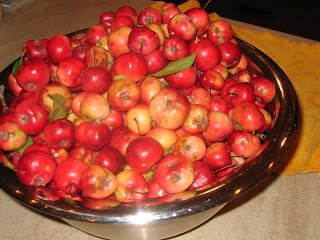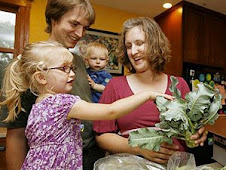She generally understands what we're doing and what it means for her (and she somewhat understands why we're doing it). I regularly overhear her narrating her play and she'll ask a pretend vendor, "Is it local?" or play-act making her own food. She also asks questions of me about what is and isn't local on a regular basis and when I answer that something is not, she moves on to the next thing.
Well, today we spent a few hours at the Rock River Thresheree and Steam Show in Edgerton, WI (thanks for our friends Joe and Jeff who recommended it!). While there, Neva saw many people walking around with lemonade - definitely off of our list! She has been pretending to make and serve lemonade quite a bit lately as one of the storybook characters she likes sets up a lemonade stand and she pretends to do the same.
When we walked by one of the lemonade booths she asks (very politely) if she may have some lemonade. Kevin and I give each other the same "gee, we really would like to say 'yes' but we don't want to buy citrus AND sugar so what should we do?" look. Kevin tells her that he will let her make the decision but she should know that lemonade is not local. He asked her if she would like some and she said, "no." My heart soared as I thought, "wow, she's really willing to 'take one for the team'." We both affirmed her decision as we moved along. As we walked away I noticed that her head was hung low, really low, and she was silently crying as she walked with us.
I stopped and knelt down to talk to her and asked her why she was feeling sad. She said that she really wanted to try lemonade but it wasn't local so she wouldn't have any. I just gave her a big hug and told her how proud of her I was for her to make that decision and to be willing to go along with our experiment like that. I told her that she was awesome and I loved her and that I wanted to reward her for being so wonderful and not making a fuss and sticking to it. And then I told her that I would reward her by buying her a lemonade... gasp!
She looked at me incredulously, as if she couldn't believe what I was telling her. This was no ploy on her part to get what she wanted, she was truly sad but willing to forgo the treat. I was really serious though and we went and waited in line and she got a "small" lemonade (at least it was real lemonade and not the powered stuff) and was so, so happy.

For the most part, she is unaffected by our fun and challenging project. She still gets great food, lots of variety, and a fair amount of desserts and snacks - as long as it all comes from within 100 miles. She helps me make and prepare many things and is excited about what we can produce and especially enjoys our regular visits to area farms. She is rarely phased when I tell her we can't have something or make something we used to because we don't have all of the ingredients available to us. But it just broke my heart to see her being so good but so sad today and I'm glad we gave in to give her a special treat and reward her for being such a good little trooper.









